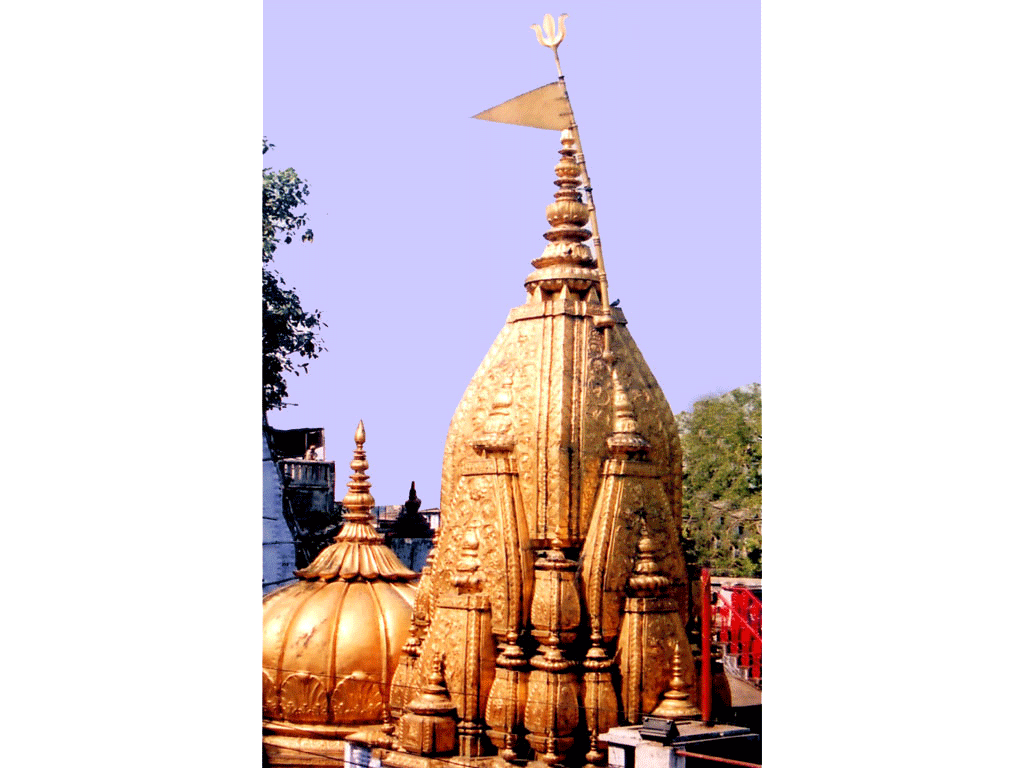The Temple of Kasi Vishwanath is perhaps the most popular temple in the country and is renowned the world over. The temple is in the holy town of Benares or Varanasi on the banks of the sacred River Ganges. The temple forms part of the twelve "Jyothirlinga" Shrine framework of temples dedicated to Lord Shiva and the Siva Linga here is said to be the first "Jyothirlinga".  Goddess Visalakshi here is considered an important manifestation of Goddess Parvathi and her abode is one of the most important of the Eighteen "Asthadasa Sakthi Peethams". The temple is one of the most important places in Hinduism and as such should be visited once in every lifetime. Also called the golden temple, this temple has withstood many tougher periods of Indian history. The Lord's darshan here is said to grant "Moksha" or salvation. The Lord is said to reside here and teach the "Tarak Mantra" to devotees who die here.
Goddess Visalakshi here is considered an important manifestation of Goddess Parvathi and her abode is one of the most important of the Eighteen "Asthadasa Sakthi Peethams". The temple is one of the most important places in Hinduism and as such should be visited once in every lifetime. Also called the golden temple, this temple has withstood many tougher periods of Indian history. The Lord's darshan here is said to grant "Moksha" or salvation. The Lord is said to reside here and teach the "Tarak Mantra" to devotees who die here.
History
As of now, records pertaining to the origins are not available as the temple was under constant attacks from foreign invaders due to it being considered one the symbols of Hinduism. The temple has been destroyed and rebuilt many times during the middle ages. The trend may have had started with Mohammed Ghazini in the first half of the eleventh century. Many muslim rulers invading India during those times used to have no tolerance towards other religions, Hinduism in particular, and so went on a rampage destroying many temples around the country and Kasi was not spared too. Mohammed ghori also attacked the temple around 1193 AD to suppress Hinduism, followed later on the Infamous Aurangazeb. The Moghal emperor Akbar was the only exception to these acts of demolition and he actually contributed significantly towards the temple's activities. The muslim domination continued until the Marathas took control of the city. Much of the present structure is actually constructed in 1780 AD by Maharani Ahilya Bai Holkar of Indore. Governor General Warren Hastings also oversaw some enhancements to the temple. The temple is also called the "Golden temple" from its Gold covered Spire and Dome, built with a thousand kilo gold donation from King Ranjit Singh of Punjab in 1835. As is the case in most states of the country, this gem of a temple is now under the hands of the state government.
Legends abound, the temple is situated in the holy city of Benares, considered the oldest city in the world still inhabited. The city has a history of 3500 years and is a major center of trade, arts and science in the country those days.
Legends
Innumerable legends are associated with this ancient hindu temple. Legend, has it that Lord Shiva, in a bid to clear all doubts as to his supremacy among Gods, created the first "Jyothirlinga" at this place and created the city along with Goddess Parvathi. The original Shiva Linga that formed is said to be hidden in the Gynana Vapi or the well of knowledge present within the temple's premises.
Legend has it that, after the ill-treatment meted out to her by her own kin while attending a Yajna being performed by her father, uninvited, Goddess Parvati ended her own life out of embarrassment to face Lord Shiva. An infuriated Lord Shiva decimated king Daksha immediately upon knowing this but couldn't overcome the grief and depression over his consort's fate. The Gods tried to console Lord Shiva but couldn't make him get over the matter. Lord Vishnu sent his chakra, which cut the Goddess's body resting over Lord Shiva's shoulder into eighteen parts that fell over different parts of the country. The eighteen places where the parts fell are called Asthadasa Sakthi Peethams and as one of the Goddess's three eyes fell here at this place, the goddess here came to called as Goddess Visalakshi (wide eyed, implying a divine eye overseeing the universe)
Legend about the Manikarnika Ghat, it that Goddess Parvathi, to divert the Lord from his devotees, hid her earrings and asked Lord Shiva to find them on the banks of the Ganges River, an act that will continue forever giving rise to the legend that the Lord asks the soul of everybody cremated here as to the whereabouts of the earrings.
Festivals
The most important festivals celebrated at the temple are Mahasivaratri falling in the months of February/March and Navaratri, a nine day long festival celebrating the glory of Goddess Parvathi, falling in the months of October/November. Nag Panchami festival is also celebrated with religious fervor.
References
The temple is referenced to many times in many ancient texts like the Rig Veda, Skanda Puran, Ramayan and the great epic of Mahabharata. The great Hindu saint Adi Sankaracharya is said to have written about Hinduism here. The famous Chinese traveler Huien Tsang visited this place.
Annadanam
- Free Nithya Annadanam (Unit - 1) at Back Side of Annapurna Devi Temple. Phone: 0542-2402253, 6540396.
- Free Nithya Annadanam (Unit - 2) at Aparnath Math Temple,Near Gate No. 1. Phone:0542-2402252,6540008.
- Free Meals to the Poor at Lalita Ghat after Mangal Harathi every day.